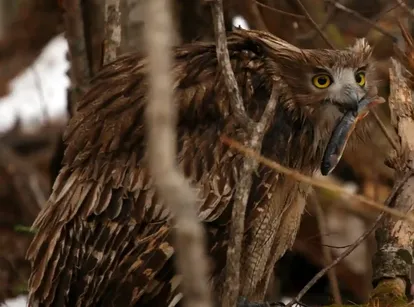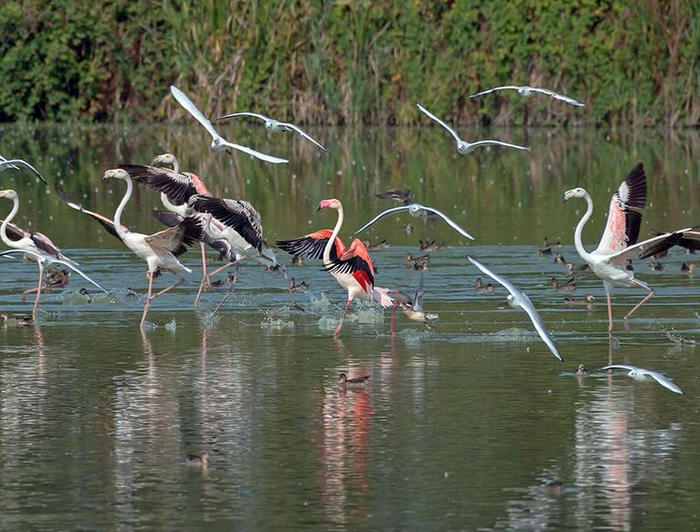Jonathan C. Slaght with a fish owl in 2007 in Russia. Amur-Ussuri Center for Avian Biodiversity
There are still stories that arouse the emotion of the classic tales of adventures in the wild by Jack London, James Curwood or Fenimore Cooper.
Although in this case the most exact reference would be
Through the Territory of Ussuri
and
Dersu Uzala
, the books by explorer and naturalist Vládimir Arséniev that gave rise to Akira Kurosawa's unforgettable film.
Boundless forests, wild animals, untamed men and lands, dangers, the poetry of extreme loneliness under a boundless sky and the plethoric sensation of filling one's lungs with clean, free air in a remote corner of the world.
All this, from a current sensibility, of environmentalism, conservationism and
nature writing
, peppered with an indispensable sense of humor when you stalk a rare bird at more than 20 degrees below zero and wet, is what
Owls of the ice of Este
offers ,
an exciting expedition
(Siruela, 2022).
American naturalist Jonathan C. Slaght's book is one of the big surprises of the literary season: Nature Book of the Year for
The Times
, shortlisted for the National Book Award in the non-fiction category, praised by Helen Macdonald and Jennifer Ackerman , does not leave any reader indifferent in his way of immersing us in the icy immensities of the Russian Far East to meet the strange and extravagant Manchu owl or Blakiston's fish owl
(Bubo blakistoni
), a legendary bird with piercing yellow eyes, the largest nocturnal bird of prey on the planet, in competition with the eagle owl.
It weighs about 11 crows, more than 4.5 kilos (females, 25% larger than males), and has a wingspan of 2 meters.
More information
Bird books: when reading really gives you wings
Slaght spent five years chasing this veritable ghost - an evanescent aerial sprite that nests in towering trees and feeds on the fish and frogs it catches in the rivers - in the breathtaking landscapes of Primorye, an untamed Russian region that borders China. North Korea and the Sea of Japan.
The mysterious fishing owl, of which 186 pairs remain in Primorye and less than 2,000 individuals in the world, is a symbol of these lands as the Siberian tiger is of the neighboring Amur region.
What a biologist from Minnesota was doing in the Russian
Far East
chasing owls is explained by Slaght's personal relationship with the territory.
He has been visiting those lands for more than 20 years, the first time was in 1995 after accompanying his father on a business trip to Russia;
then three years there as a young volunteer for the Peace Corps, the US federal international aid agency — when he learned Russian and befriended local naturalists, developing his interest in ornithology and
birdwatching
— and finally in 2005 as a postgraduate from the University of Minnesota with the research project on the fishing owl, a little-known and threatened creature.
The plan consisted first of locating them in the different areas where they had been reported, then capturing them and placing tracking devices on them, and finally, with the data obtained, assessing the status of the species and designing a conservation program.
Put like that it sounds simple, but the book follows the immense problems, frustrations and dangers of doing field work and trying to establish a relationship with an elusive nocturnal raptor (luckily the fishing owls, unlike their conspecifics, make noise when flying, for the adaptation of its plumage to diving) in 20,000 square kilometers.
Helicopter trips, all-terrain, snowmobiles, overnight stays in lonely cabins, long night-time excursions on foot and skiing in a hostile and frozen environment, flooding rivers (in a Slaght he saved a drowning roe by arm, stretching it antlers), brittle ice, wild beasts (the area is teeming with bears, tigers, and leopards), leathery, dubious, and quirky fellow travelers including poachers and ex-criminals, literally drenched in vodka,
The hardness of the mission and its scientific objective are not an obstacle for the naturalist to describe with great literary breath the monumental beauty of the places.
What is the most beautiful thing he has seen there?
"It is not easy to answer," explains Slaght in conversation with this newspaper.
“I have over 20 years of experience in that part of the world and there are so many wonderful things... One of my favorite memories is a morning sailing along the coast, looking up at the cliffs through the mist, with cormorants and other waterfowl flying by. flush with the water, and a herd of sika deer moving slowly on the rocky beach in search of nutrient-rich algae.
Everything radiated a great sense of peace.”
For the naturalist, translator by the way of Arseniev, it is "a liberating experience" to be in those wild latitudes.
"I live most of the year in a city, so spending months in a place where tiger tracks are more abundant than human footprints is very exciting."
How are the owls, those feathered goblins?
“Owls are OK!
There have been recent issues with climate change, when big storms have knocked down the huge old trees that they nest in, but the work we've done locating those nests is helping."
Russian Primoire Owl with a fish in its beak.JC SLAGHT
Of the sensation produced by having a fish owl in your hands, he explains: “It is a very special experience, they are birds that do everything possible to remain hidden from humans, they tend to move away at distances of 100 or 150 meters if they see you approaching, so they definitely don't want you to catch them!
They are calm in the hand, more than I thought at first.
But you still have to be careful, especially with the claws.”
Of the discoveries they have made about the Manchu owls, he points out: “In general, science knew very little about Blakiston's fishing owls.
For example, before our research, no one even knew how to tell a male from a female [they are sexed by the proportion of white in their tail feathers].
What our project has done is determine the best types of forest for these owls, giving us a basic understanding of their needs.
There is much more to learn yet."
Slaght indicates that there are four species of fish owl in Asia: Blakiston, chestnut or Ceylon, tawny and Malayan, "although we recently published an article in
Avian Research
suggesting that the Blakiston should be further divided into two species: one in mainland northeast Asia and the other mostly in Japan -
Using bioacoustic tools to clarify species delimitation within the Blakiston's Fish Owl (Bubo blakistoni) complex-”.
What is it about owls in general that makes them so mysterious and fascinating to us?
It seems that in reality—and don't take this personally—they aren't exactly among the most intelligent of birds.
“The simple fact that they are nocturnal, active at night, or crepuscular, active between sunset and sunrise, makes them enigmatic to us.
We don't normally see owls as often as hawks or eagles, perched on poles or on roads, so the perception of rarity makes any encounter special."
Of the people, as important in your book as the animals and the landscape, which characters impressed you the most?
“Anyone who can live and thrive in such an inhospitable environment has my utmost respect.
I met an individual named Volodya Loboda in the village of Agzú.
He only had one arm, but he was considered the best hunter in the region.
That he could not only still shoot a rifle but be the best with it is very impressive."
As to whether there were times when he really felt in serious danger, he replies: “All the time!
There was continually the risk of drowning.
I was never really worried about attacks from tigers or bears, blizzards or weird people, but drowning was definitely a danger."
Tigers and bears appear in the book.
“I have seen both.
Bears hibernate in winter, which is when most of the book takes place, so we don't see much of each other.
He explained that we saw a lot of tiger tracks.
However, the tigers themselves can be quite difficult to see.
As prevention for bears and tigers, he carried hand-held flares, the ones from the boats, that should be enough to scare them away.”
In the book he mentions the case of a man-eating tiger that killed an individual in 2010 who was fishing in the Serebrianka, in the heart of the owls' territory, do you know
El tigre,
by John Vaillant, about the hunt for one of those beasts in the area?
“I have read the Vaillant book, yes, and I have met John several times.
In fact, he was in Primorye doing research for
El tigre
at the same time I was studying fishing owls, and at one point we faced the same storm, him on one side of the mountain and me on the other!
But we didn't find out until later."
Slaght with a fish owl by Blakiston. Editorial Siruela.
When Slaght—currently a project manager for the Wildlife Conservation Society and co-founder of the Blakiston's Fish Owl Project with Russian ornithologist Sergei Surmach—is told that Primorye looks like a godforsaken land, in terms of human life , and quite unhappy, reacts vividly: “I think it's the opposite, it's a very favored place.
People can live honest and healthy lives there by hunting and fishing, and enjoying nature.
They don't have much faith in the infrastructure offered in richer corners of civilization, but that doesn't mean they are unhappy."
Duet with Colin Thubron
Do you know and have read Slaght Colin Thubron, the veteran British travel writer?
Thubron has spoken admiringly of
Eastern Ice Owls
and his latest recently published book is precisely a journey following the course of the Amur River to the Pacific.
In the crossing of both voices, Slaght and Thubron, there is a reminiscence of the resounding duets of the Manchu owls!
“I don't know Thubron personally, but of course I know who he is and I've read some of his Russian-themed books.
I didn't know you had enjoyed my owl book.
It's nice to know.
I have his new book,
The Amur river,
on my reading list.
The comparison is very kind, and I would be very happy to duet with Colin at any time."
Eastern Ice Owls
has a literary quality rare in most scientific books.
What are Slaght's literary references, in general and in nature literature? And what do you think of
nature writing
?
“I have great admiration for Bernd Heinrich, his book
Ravens in Winter
made me realize that I could turn my interest in birds into a profession, and also gave me the confidence to write about my own experiences in the field.
John McPhee [the author of
Coming into the country
, about Alaska] writes beautifully, as does Peter Matthiessen.
They are probably my favorite nature authors.
I'm obviously a fan of nature writing.
The natural environment is in constant danger and people cannot take care of something if they do not feel a connection with it.
Nature
writing
provides that important connection.”
Exclusive content for subscribers
read without limits
subscribe
I'm already a subscriber





